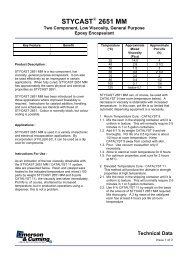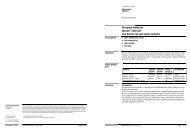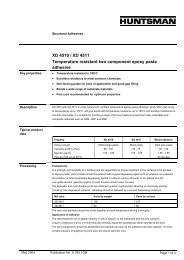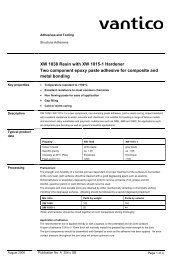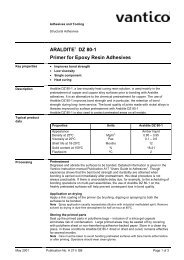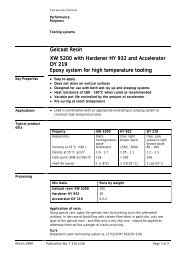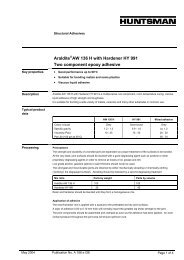Araldite 4905 A/B Polyurethane adhesive for primerless SMC bonding
Araldite 4905 A/B Polyurethane adhesive for primerless SMC bonding
Araldite 4905 A/B Polyurethane adhesive for primerless SMC bonding
You also want an ePaper? Increase the reach of your titles
YUMPU automatically turns print PDFs into web optimized ePapers that Google loves.
Adhesives and ToolingStructural AdhesivesKey propertiesDescription<strong>Araldite</strong> <strong>4905</strong> A/B<strong>Polyurethane</strong> <strong>adhesive</strong> <strong>for</strong> <strong>primerless</strong> <strong>SMC</strong> <strong>bonding</strong>• Fast curing - only room temperature curing is necessary <strong>for</strong> <strong>primerless</strong> <strong>SMC</strong> <strong>bonding</strong>• 5 minute open time• Flexible• Bonds well to most coated metals and composite materials• Suitable <strong>for</strong> use in gravity fed pumping systems (follower plates not required)• Gap filling capability up to 10mm<strong>Araldite</strong> <strong>4905</strong> A/B is a two component, room temperature curing, polyurethane <strong>adhesive</strong> specially designed <strong>for</strong><strong>primerless</strong> <strong>bonding</strong> of <strong>SMC</strong> and coated metals. The components can be gravity fed to meter-mix equipment, and themixed <strong>adhesive</strong> develops excellent sag resistance and gap filling capability. The toughness of the cured <strong>adhesive</strong>results in high impact resistance and good fatigue per<strong>for</strong>mance, coupled with excellent resistance to fuels and oils.TypicalProduct data Properties <strong>Araldite</strong> <strong>4905</strong> A <strong>Araldite</strong> <strong>4905</strong> B mixed <strong>adhesive</strong>Colour (visual) Biege Biege BiegeSpecific gravity ca. 1.5 ca. 1.25 ca. 1.35Viscosity (Pas) at 23°C ca. 20 ca. 20 highly thixotropicGap filling capability (mm) - - 10 mm.Pot Life (in static mixer 08 x 18 at 23°C)4 minutesOpen time at 23°C / 65% RH - - 5 minutesProcessingPre-treatment/Surface preparationThe strength and durability of a bonded joint are dependant on proper preparation of the surfaces to be bonded.This <strong>adhesive</strong> is suitable <strong>for</strong> <strong>primerless</strong> <strong>bonding</strong> of <strong>SMC</strong> surfaces. For best results when <strong>bonding</strong> without primer, the<strong>SMC</strong> surfaces have to be dry and free from contamination such as grease, oil, or dust. Typically a dry wipe of the<strong>SMC</strong> surfaces to remove dust is sufficient <strong>for</strong> <strong>primerless</strong> adhesion. Greasy contamination is best removed with asuitable degreasing solvent.Bonding surfaces other than <strong>SMC</strong>, eg. Metals, composites and thermoplastic substrates, may require a specific pretreatmentsuch as abrasion, chemical etching, flame or plasma treatment in order to get optimum results. Furtherin<strong>for</strong>mation on pre-treatment of a wide variety of substrates is available from Vantico upon request.Mix ratio Parts by weight Parts by volume<strong>Araldite</strong> <strong>4905</strong> A 100 100<strong>Araldite</strong> <strong>4905</strong> B 85 100Application of <strong>adhesive</strong>The resin/hardener mix is applied directly or with a spatula, to the pretreated and dry joint surfaces.The joint components should ideally be assembled and clamped as soon as the <strong>adhesive</strong> has been applied, takingcare not to exceed the stated open time of the <strong>adhesive</strong>. An even contact pressure throughout the joint area willensure optimum cure.March 2001 Publication No. A 457 a GB Page 1 of 4
Mechanical processingSpecialist firms have developed metering, mixing and spreading equipment that enables the bulk processing of<strong>adhesive</strong>. Vantico will be pleased to advise customers on the choice of equipment <strong>for</strong> their particular needs.Equipment maintenanceAll tools should be cleaned be<strong>for</strong>e <strong>adhesive</strong>s residues have had time to cure. The removal of cured residues is adifficult and time-consuming operation.If solvents such as acetone are used <strong>for</strong> cleaning, operatives should take the appropriate precautions and, in addition,avoid skin and eye contact.Times to minimum lap shear strengthTemperature 23°C 120°C between hot plates**Cure time to reach hours - -LSS > 1N/mm 2 minutes 20 1Cure time to reach hours 2 -LSS > 90% of final strength minutes - 3LSS = Lap shear strength. ** Tested at 23°C immediately after cooling from cure conditionTypical curedpropertiesUnless otherwise stated, the figures given below were all determined by testing standard specimens 25mm width.The joint area was 12.5 x 25 mm in each case using 0.5mm bond thickness unless otherwise stated..The figures were determined with typical production batches using standard testing methods. They are providedsolely as technical in<strong>for</strong>mation and do not constitute a product specification.Average lap shear strengths of typical <strong>SMC</strong> joints (ISO 4587)Cured <strong>for</strong> 7 days at 23 o C and tested at 23°CPretreatment - Dry wipe Note - * indicates fibre tear of <strong>SMC</strong> substrate<strong>SMC</strong> Class A<strong>SMC</strong> Flexible<strong>SMC</strong> Low density<strong>SMC</strong> Structual<strong>SMC</strong> Class A toElectrocoated steelN/mm 2 0 5 10*****15Average lap shear strengths of typical non-<strong>SMC</strong> joints (ISO 4587)Cured <strong>for</strong> 7 days at 23°C o C and tested at 23°CPretreatment - Metals by sandblasting, plastics by light abrasion and iso-propanol degreasingAluminiumGalvanised steelABSPolycarbonatePVCGRPN/mm 2GRE0 5 10 15 20March 2001 Publication No. A 457 a GB Page 2 of 4
Lap shear strength on <strong>SMC</strong> joints versus temperature (ISO 4587) (typical average values)Cure: 7 days at 23°C Pretreatment - dry wipe Note - * indicates fibre tear in the <strong>SMC</strong> substrate-40ºC 23ºC 80ºC0 5 10 15*<strong>SMC</strong> Class A**<strong>SMC</strong> Flexible***<strong>SMC</strong> low density<strong>SMC</strong> Structual* ***Roller peel test (ISO 4578)Cured 7 days at 23°C and tested at 23°C on chromic acidpickled aluminium7.6 N/mmGlass transition temperatureca. 50°CTensile strength (ISO R527 type 1)Tensile modulusElongation at break16 MPa700 MPa33%Linear shrinkage during cure< 1 %Lap shear strength on <strong>SMC</strong> versus immersion in various media (typical average values)Cure: 7 days at 23°C and tested at 23°CPretreatment - dry wipe14 days ageing/immersion unless otherwise indicated*As-made valueN/mm 2 0 5 10 15Water at 23º C (25 days)*Tropical humidity40ºC/95% RH*Gasoline*Diesel fuel*Brake fluid*Air at 80°C** indicates fibre tear in the <strong>SMC</strong> substrateMarch 2001 Publication No. A 457 a GB Page 3 of 4
StorageHandlingprecautions<strong>Araldite</strong> <strong>4905</strong> A and B may be stored at 6 - 28°C provided the components are stored in sealed containers. Theexpiry date is indicated on the label. Product sold by Vantico will have at least 6 months life remaining at the dateof sale. Cartridges should not be stored <strong>for</strong> long periods after removal from the foil overpack.CautionVantico products are generally quite harmless to handle provided that certain precautions normally taken when handlingchemicals are observed. The uncured materials must not, <strong>for</strong> instance, be allowed to come into contact with foodstuffs orfood utensils, and measures should be taken to prevent the uncured materials from coming in contact with the skin, sincepeople with particularly sensitive skin may be affected. The wearing of impervious rubber or plastic gloves will normally benecessary; likewise the use of eye protection. The skin should be thoroughly cleansed at the end of each working period bywashing with soap and warm water. The use of solvents is to be avoided. Disposable paper - not cloth towels - should beused to dry the skin. Adequate ventilation of the working area is recommended. These precautions are described ingreater detail in Vantico publication No. 24264/3/e Hygienic precautions <strong>for</strong> handling plastics products of Vantico and inthe Vantico Material Safety Data sheets <strong>for</strong> the individual products. These publications are available on request and shouldbe referred to <strong>for</strong> fuller in<strong>for</strong>mation.VanticoAdhesives and ToolingDux<strong>for</strong>d, CambridgeEngland CB2 4QAAll recommendations <strong>for</strong> the use of our products, whether given by us in writing, verbally, or to be implied from the results of testscarried out by us, are based on the current state of our knowledge. Notwithstanding any such recommendations the Buyer shallremain responsible <strong>for</strong> satisfying himself that the products as supplied by us are suitable <strong>for</strong> his intended process or purpose.Since we cannot control the application, use or processing of the products, we cannot accept responsibility there<strong>for</strong>. The Buyershall ensure that the intended use of the products will not infringe any third party’s intellectual property rights. We warrant thatour products are free from defects in accordance with and subject to our general conditions of supply.© Vantico PLC, 2001® <strong>Araldite</strong> is a Registered Trademark of Vantico AG, Basel, Switzerland.Tel: +44 (0) 1223 832121Fax: +44 (0) 1223 493322www.vantico.comMarch 2001 Publication No. A 457 a GB Page 4 of 4



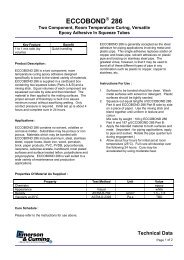
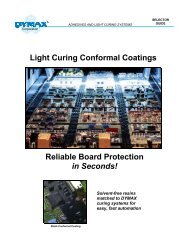
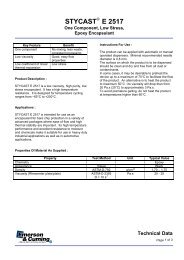
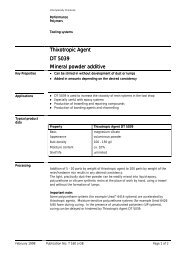
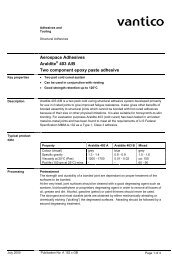
![[pdf] EXXON-TF56-TD - Lindberg & Lund AS](https://img.yumpu.com/52492677/1/190x245/pdf-exxon-tf56-td-lindberg-lund-as.jpg?quality=85)
